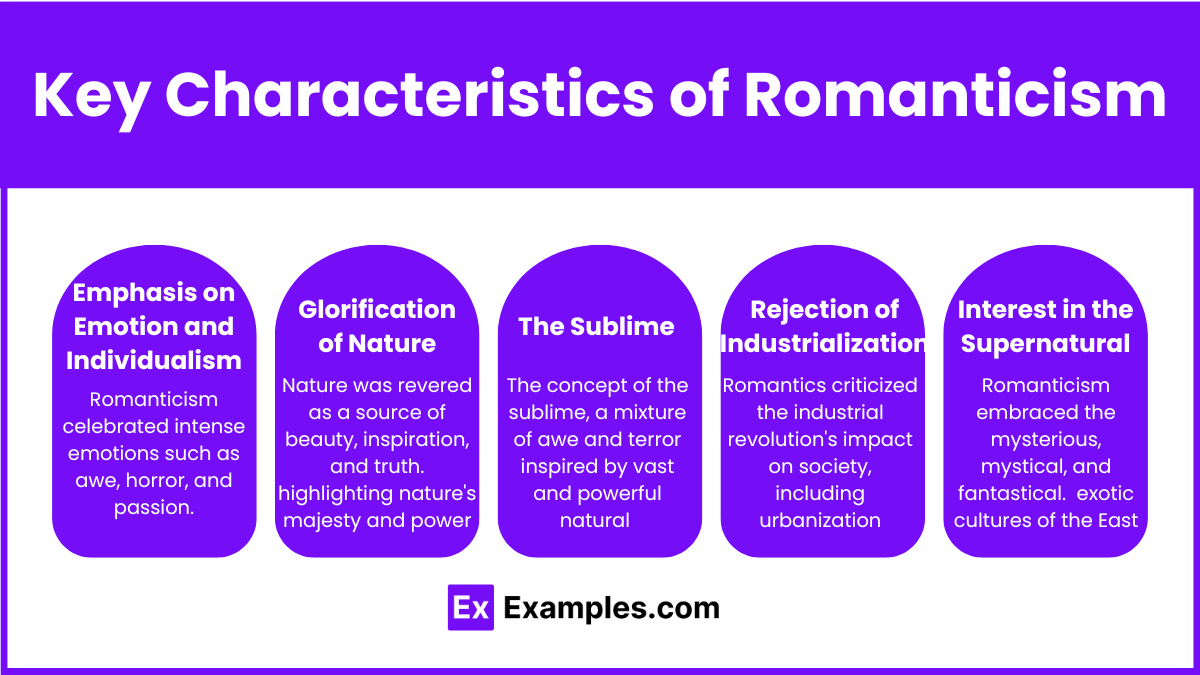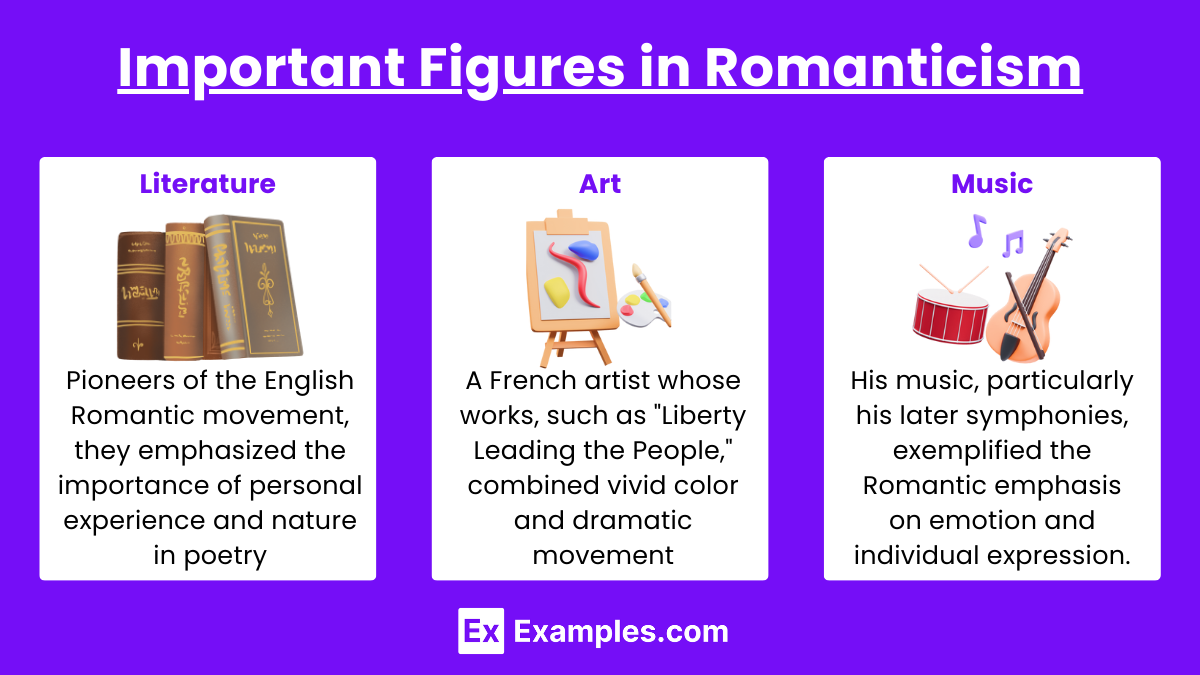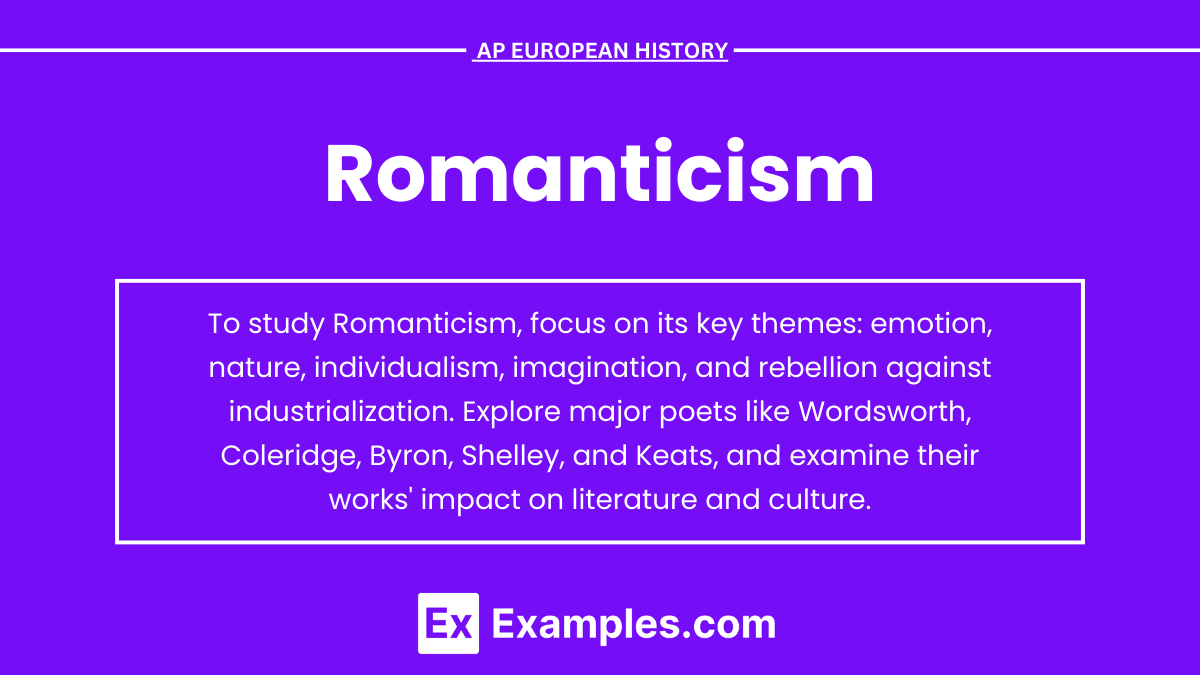Romanticism, an influential artistic and intellectual movement, emerged in late 18th-century Europe as a reaction to the Enlightenment and the Industrial Revolution. It celebrated emotion, individualism, and the beauty of nature, often glorifying the past, especially the medieval era. Romanticism emphasized the sublime, the supernatural, and the exotic, challenging rationalism and societal norms. This movement profoundly impacted literature, art, and music, shaping cultural and nationalist sentiments across Europe and influencing the course of modern thought and expression.
Learning Objectives
Understand the core principles of Romanticism in the context of AP European History, focusing on emotion, individualism, nature, and medievalism. Study the works and influence of key Romantic figures like William Wordsworth, Johann Wolfgang von Goethe, Victor Hugo, Caspar David Friedrich, and Ludwig van Beethoven. Analyze how Romanticism reacted against the Enlightenment and Industrial Revolution and its role in fostering nationalist movements. Finally, grasp the movement’s cultural impact across literature, art, and music, shaping 19th-century European thought and identity.
Key Characteristics of Romanticism

- Emphasis on Emotion and Individualism:
- Romanticism celebrated intense emotions such as awe, horror, and passion. It valued personal experience and the individual’s inner world, promoting the idea of the artist as a unique creator whose expression of emotions was paramount.
- Glorification of Nature:
- Nature was revered as a source of beauty, inspiration, and truth. Romantics often depicted landscapes in their art and literature, highlighting nature’s majesty and power. They saw nature as a refuge from the industrialization and urbanization of the time.
- The Sublime:
- The concept of the sublime, a mixture of awe and terror inspired by vast and powerful natural landscapes, was central to Romantic thought. This idea was often depicted in art and literature, emphasizing the insignificance of humanity in the face of nature’s grandeur.
- Rejection of Industrialization and Modernity:
- Romantics criticized the industrial revolution’s impact on society, including urbanization, environmental degradation, and the alienation of the individual. They idealized rural life and the past, often yearning for a return to simpler, more authentic ways of living.
- Interest in the Supernatural and Exotic:
- Romanticism embraced the mysterious, mystical, and fantastical. This interest extended to the supernatural, folklore, and the exotic cultures of the East, which Romantics saw as more genuine and uncorrupted by Western rationalism.
Important Figures in Romanticism

- Literature:
- William Wordsworth and Samuel Taylor Coleridge: Pioneers of the English Romantic movement, they emphasized the importance of personal experience and nature in poetry.
- Johann Wolfgang von Goethe: A key figure in German literature, Goethe’s work, particularly “The Sorrows of Young Werther,” exemplified the Romantic focus on individual emotion and the sublime.
- Victor Hugo: A central figure in French Romanticism, Hugo’s novels, such as “Les Misérables” and “The Hunchback of Notre-Dame,” combined social critique with a celebration of human emotion and spirit.
- Art:
- Caspar David Friedrich: A German painter known for his landscapes that evoke the sublime, often depicting solitary figures in vast, overwhelming natural settings.
- Eugène Delacroix: A French artist whose works, such as “Liberty Leading the People,” combined vivid color and dramatic movement, embodying the Romantic spirit of revolution and emotion.
- Music:
- Ludwig van Beethoven: His music, particularly his later symphonies, exemplified the Romantic emphasis on emotion and individual expression.
- Franz Schubert: An Austrian composer known for his lieder (songs) that often focused on themes of nature, love, and melancholy.
Impact of Romanticism on Society and Culture

The Impact of Romanticism on Society and Culture refers to the significant influence of the Romantic movement on European identity, politics, and social norms. This influence includes fostering national pride, inspiring political movements for independence and liberalism, and redefining concepts of love, beauty, and nature, encouraging personal expression and creativity in art and literature.
1. Nationalism and Cultural Identity
Romanticism spurred a strong sense of national identity across Europe. It led to the rediscovery of national legends, folklore, and traditional languages, fostering pride in cultural heritage. This movement was especially important in countries like Germany and Italy, where it supported efforts toward unification and independence.
2. Political Movements and Revolutions
The Romantic emphasis on individualism and emotion influenced various political movements, including support for revolutions and national independence. The movement inspired liberal and nationalist causes, such as the Greek War of Independence and the Italian Risorgimento, promoting ideals of freedom and justice.
3. Social and Cultural Norms
Romanticism reshaped societal views on love, beauty, and nature. It introduced the concept of passionate, individualistic romantic love and promoted an appreciation of nature’s beauty and spiritual significance. Additionally, it challenged classical artistic standards, encouraging originality and personal expression in art and literature.
Examples of Romanticism
- “The Wanderer Above the Sea of Fog” by Caspar David Friedrich : This iconic painting depicts a lone figure standing atop a mountain, gazing out over a fog-covered landscape. The artwork emphasizes the power and beauty of nature, as well as the emotional experience of solitude, both key elements of Romanticism.
- “Ode to a Nightingale” by John Keats : In this poem, Keats explores themes of nature, beauty, and the fleeting nature of human life. The nightingale’s song symbolizes an ideal beauty that transcends the harsh realities of the world, a common motif in Romantic literature.
- “Frankenstein” by Mary Shelley : Shelley’s novel is a prime example of Gothic Romanticism. It delves into the dangers of unchecked ambition and the consequences of playing God. The story also explores the sublime, a concept often associated with Romanticism, through the awe-inspiring and terrifying aspects of nature and creation.
- “The Ninth Symphony” by Ludwig van Beethoven : Beethoven’s symphony embodies the Romantic ideals of individualism and emotional expression. The final movement, featuring the “Ode to Joy,” expresses a profound sense of unity and exaltation, capturing the Romantic spirit of striving for the sublime and the universal.
- “Wuthering Heights” by Emily Brontë : This novel presents a dark and intense portrayal of passion and the human soul. The moors, a wild and untamed landscape, mirror the tumultuous emotions of the characters, particularly in the doomed love story between Heathcliff and Catherine, highlighting Romanticism’s fascination with emotion and nature.
Practice Test Questions on Romanticism
Question 1: Which of the following is a characteristic of Romanticism?
A) Emphasis on reason and logic
B) Celebration of nature and individual emotion
C) Focus on industrialization and urban life
D) Adherence to strict classical forms and rules
Answer: B) Celebration of nature and individual emotion
Explanation: Romanticism was a literary and artistic movement that emerged in the late 18th century. It emphasized the importance of nature, individual emotion, and imagination, contrasting with the rationalism and restraint of the Enlightenment and Neoclassicism. Romantics valued personal experience and the beauty of the natural world, often expressing a deep reverence for the sublime aspects of nature.
Question 2: Which Romantic poet is known for the concept of the “sublime” in nature?
A) John Milton
B) William Wordsworth
C) Alexander Pope
D) Robert Frost
Answer: B) William Wordsworth
Explanation: William Wordsworth, a leading figure of the Romantic movement, is renowned for his deep appreciation of the natural world and his exploration of the sublime—a quality of greatness or vastness that inspires awe and wonder. Wordsworth’s poetry often reflects his belief that nature is a source of spiritual nourishment and emotional insight, a central theme in works like “Lines Composed a Few Miles Above Tintern Abbey.”
Question 3: How did Romanticism differ from the preceding Enlightenment period in its view of human experience?
A) Romanticism emphasized empirical evidence over intuition.
B) Romanticism focused on the collective experience rather than individual experience.
C) Romanticism celebrated subjective experience and emotion over reason and logic.
D) Romanticism rejected the supernatural and embraced scientific rationality.
Answer: C) Romanticism celebrated subjective experience and emotion over reason and logic.
Explanation: Romanticism marked a shift away from the Enlightenment’s emphasis on reason, logic, and empirical evidence. Instead, it celebrated the importance of subjective experience, emotion, and the imagination. Romantics believed that true understanding and artistic expression came from personal feelings and individual perspective, often challenging the rationalist views of the Enlightenment. This focus on the individual’s emotional and spiritual experiences is a hallmark of Romantic literature and art.


